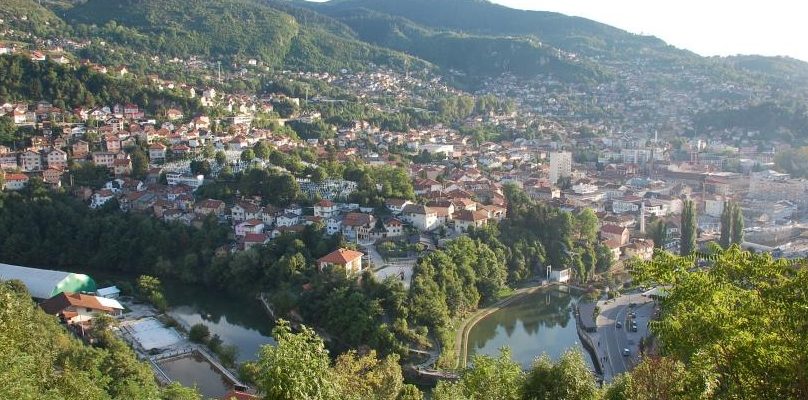Sarajevo’s Ottoman heritage
-

PHOTO ISABELLE GONTHIER, THE PRESS
Bascarsija district, Sebilj square and its pigeons
-

PHOTO ISABELLE GONTHIER, THE PRESS
Alley in the Bascarsija district
1/2
Sarajevo prides itself on being the city where Western and Eastern cultures intersect. It’s difficult to contradict its residents when you stroll through the pedestrian streets of the Bascarsija district. There is a unique atmosphere in the historic center of the capital, where the Ottoman heritage lives on in its mosques, bazaars and numerous cafes. At the heart of this sector, Sebilj Square has become a meeting place as much for humans… as for pigeons. A few minutes around the fountain are enough to be treated to their show.
The tunnel of hope

PHOTO ISABELLE GONTHIER, THE PRESS
Tunnel Museum
Surrounded by Serbian forces, Sarajevo found itself isolated from 1992 to 1995. In order to transport weapons, food and aid to residents, a tunnel was dug under the airport. When the siege was lifted, the house hiding its entrance was transformed into a museum. We were able to explore part of the underground passage with a former soldier, who himself had used it dozens of times. Almir also explained to us how people lived during this period by sharing his personal experience and memories. An unforgettable encounter.
Visit the museum website (in Bosnian)
Walk on “Sniper Alley”
-

PHOTO ISABELLE GONTHIER, THE PRESS
“Sniper Alley”, Museum of History of Bosnia and Herzegovina
-

PHOTO ISABELLE GONTHIER, THE PRESS
“Sniper Alley”: the old Holiday Inn in yellow (the hotel which hosted the journalists)
1/2
While walking along the Zmaja od Bosne Boulevard, déjà vu could arise in the heads of travelers. This is because several images were filmed there during the war: buildings on fire, people running or corpses lying on the ground. The thoroughfare had been renamed “Sniper Alley” because of the snipers lurking on rooftops and in the mountains who targeted civilians. A walk will take you to the parliament, the national museum and the history museum of Bosnia and Herzegovina. For a break, consider Caffe Tito to immerse yourself in the former Yugoslavia led by the marshal.
Unmissable mosques
-

PHOTO ISABELLE GONTHIER, THE PRESS
Old bridge seen from the Koski Mehmed-pacha mosque
-

PHOTO ISABELLE GONTHIER, THE PRESS
Koski Mehmed Pasha Mosque
-

PHOTO ISABELLE GONTHIER, THE PRESS
Koski Mehmed Pasha Mosque
1/3
In Bosnia, a predominantly Muslim country, many mosques welcome tourists, but the welcome and the rules to follow differ from one place to another. This is an opportunity to immerse yourself in the local culture and understand the rituals associated with it. We particularly enjoyed our visit to the Koski Mehmed Pasha Mosque in Mostar. Not only were questions welcome, but she is one of the few to provide access to the minaret. From up there you get the best view of the city and its old bridge.
Koski Mehmed Pasha Mosque, 16, Mala Tapa, Mostar
Street art at “Sniper Tower”
-

PHOTO ISABELLE GONTHIER, THE PRESS
Graffiti at the “Sniper Tower” in Mostar
-

PHOTO ISABELLE GONTHIER, THE PRESS
The “Sniper Tower” in Mostar
-

PHOTO ISABELLE GONTHIER, THE PRESS
Graffiti at the “Sniper Tower” in Mostar
-

PHOTO ISABELLE GONTHIER, THE PRESS
Graffiti at the “Sniper Tower” in Mostar
1/4
Due to its height and vantage point over Mostar’s main street, snipers adopted a former bank building as their hideout. From its top, they targeted passers-by and vehicles circulating in the Spanish Steps, which earned it the nickname “Sniper Tower”. Abandoned, it became a place frequented by followers of street art. Bullet marks are still visible through the graffiti that adorns its walls. The colors and political messages attempt to breathe new life into a neighborhood which still bears traces of the bombings.
Treat for carnivores
-

PHOTO ISABELLE GONTHIER, THE PRESS
Restaurant Tima-Irma, in Mostar
-

PHOTO TAKEN FROM THE TIMA-IRMA SITE
A tasting dish at Tima-Irma
1/2
Grilled meat comes up again and again when it comes to Bosnian cuisine. In Mostar, we were charmed by the flavors of the Tima-Irma restaurant. Following the advice of the friendly owner, we opted for the tasting dish consisting of beef, cevapi, chicken and sausages, accompanied by vegetables, somun bread and typical Balkan condiments. Delicious ! With its generous portions, attentive service and lively atmosphere, this place is a sure bet. So much so that we went back the next day.
Visit the Tima-Irma restaurant website (in English)
Pains of Srebrenica

PHOTO ISABELLE GONTHIER, THE PRESS
In Srebrenica, the cemetery and memorial in Potočari
A visit to Srebrenica will immerse you in the heart of the 1995 genocide, in which more than 8,000 Muslims were murdered by Serbian forces. The former base of the Blue Helmets located in Potočari has been transformed into a museum which presents, using films and photos, the atrocities committed. The cemetery and memorial were set up across the road. The tombstones lined up and the names of 8,372 victims engraved on a monument remind us of the powerlessness of the UN to protect them. To fully appreciate the visit, we recommend going with a guide.
Visit the Srebrenica-Potočari Memorial and Cemetery website (in English)
